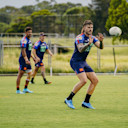10 facts about physical fitness you didn't know

Let’s bust some myths about exercise and discover some fascinating facts that might just surprise you.
When it comes to getting moving, think of nib as your health partner. To warm up this conversation, we chatted with Matthew Jay, High Performance Manager for the nib Newcastle Knights.
1. Strength training continues to burn fat long after you finish your workout
Ever heard that muscle is your body's fat-burning machine? Matthew explains:
“The more muscle you have, the more kilojoules you burn, even at rest. So, if you're doing resistance training like lifting weights, you're not just getting fit, you're also revving up your metabolism, and that fat-burning continues long after you’ve finished your workout.”
Building endurance in two ways
You can build your endurance in two ways: muscular and cardiovascular training. Muscular endurance is about doing more reps with lighter weights, while cardio (think running or swimming) keeps your heart rate up for longer. Matthew recommends combining them for a well-rounded fitness routine that’ll have you feeling strong and energised.
2. Music can improve the quality of your workout
If you have a go-to playlist for workouts, you might be onto something. Some studies show that tunes can distract you from discomfort, elevate your mood, and even boost performance while you exercise. So, don’t forget those headphones next time you hit the gym!
3. Exercise can make you happier
Physical activity is a mental health superhero. When you exercise, your brain releases chemicals such as endorphins and serotonin, which help to improve your mood. Plus, regular exercise may help reduce stress and ease symptoms of depression and anxiety.
4. A longer workout isn’t necessarily a better workout
Matthew says the best workout is the workout you do, which will depend on what you’re hoping to achieve through exercise.
“A 10-minute high-intensity session can be just as beneficial as a one-hour steady walk. Any movement is better than none."
5. You can’t target trouble spots with exercise
“Many people think concentrating on specific muscle groups when you exercise will reduce the fat in those areas. For example, doing lunges to melt away fat on the thighs or sit-ups to flatten your stomach,” Matthew says.
But spot-reduction is a myth. We burn fat from all over our body as we work out, with genes, age and hormones being some of the determining factors when it comes to reducing fat.
“The idea is to focus on full-body workouts, rather than tone just one area,” Matthew recommends.
6. Regular exercise can reduce fatigue
The thought of working out might make you feel exhausted, but if you get up and move your body, you’re likely to feel invigorated.
Physical activity is known to boost energy levels and can also minimise fatigue by helping you sleep better. Some chronic conditions, including long COVID, may be exacerbated by the wrong type or amount of exercise. Always talk to a health professional before you begin an exercise regimen.
7. Eating before a workout may help with weight loss
Have you ever wondered if you should eat before a workout? “Training while fasted can help with fat loss,” Matthew says, “but fuelling up can also boost your performance during your session.”
It all depends on whether you work out in the morning or the evening, and what’s right for your body. As a general rule, Matthew recommends having your last big meal three to four hours before exercising. You can also grab a small snack one to two hours beforehand for extra energy, and make sure you’re hydrated by sipping water before.
8. There are four types of exercise and we need them all
While cardio is an important part of a fitness regimen, it’s only one aspect of physical fitness. Strength, flexibility and balance exercises are essential for people of all ages.
“Strength exercises include weights or resistance training,” says Matthew. “Flexibility could be as simple as doing gentle stretching and bending exercises each day, or you might try a class such as tai chi, yoga or dancing. Maintaining balance is essential to help prevent falls as you age. Try doing heel raises, side leg raises and even toe-heel walking in a straight line.”
9. Different activity requirements apply to different age groups
Our activity requirements change as we age. Kids aged five to 17 should aim for at least 60 minutes of exercise daily. Adults aged 18 to 64 should be active most days for 2.5 to five hours weekly. And for our seniors (65 and over), 30 minutes of moderate activity on most days is recommended according to Australian Government guidelines.
10. Exercise can improve your focus, concentration and memory
Exercise doesn’t just help your body, it can improve brain function. As you work out, blood flow increases to your brain, improving focus and concentration. Plus, regular activity can even increase the size of the hippocampus, which is the part of the brain responsible for memory.
Matthew reminds us, "Any movement is good movement. Just find what feels right for you."
Whether you’re going for a brisk walk, shaking it up in a dance class, or hitting the weights, the goal is to keep moving and have fun. Listen to your body and pick activities you enjoy, so exercise becomes a natural and enjoyable part of your life.
Whether you're just getting started or pushing your limits, nib Rewards helps you save while you stay active.
The tips throughout this article serve as broad information and should not replace any advice you have been given by your medical or allied health practitioner.
